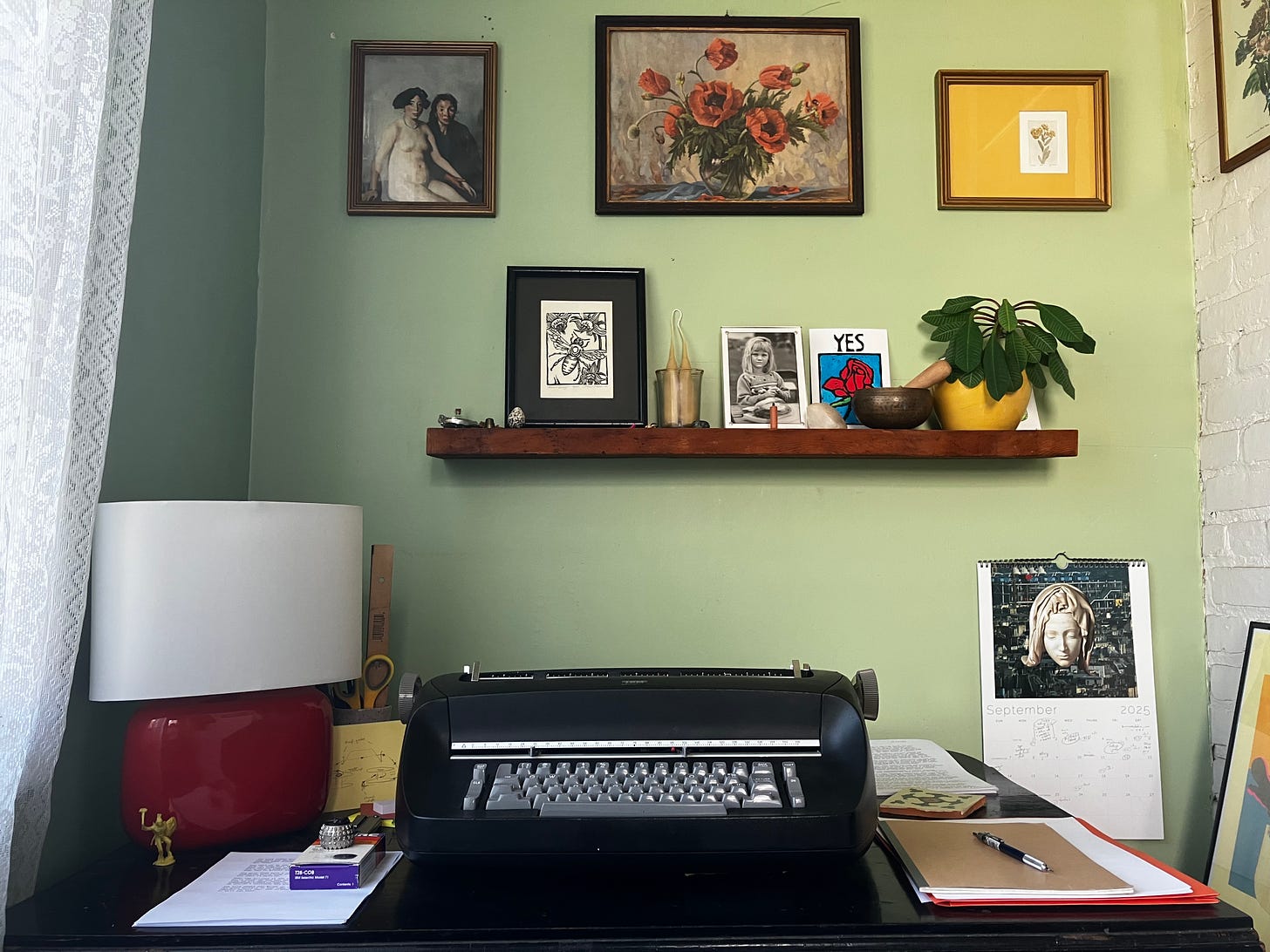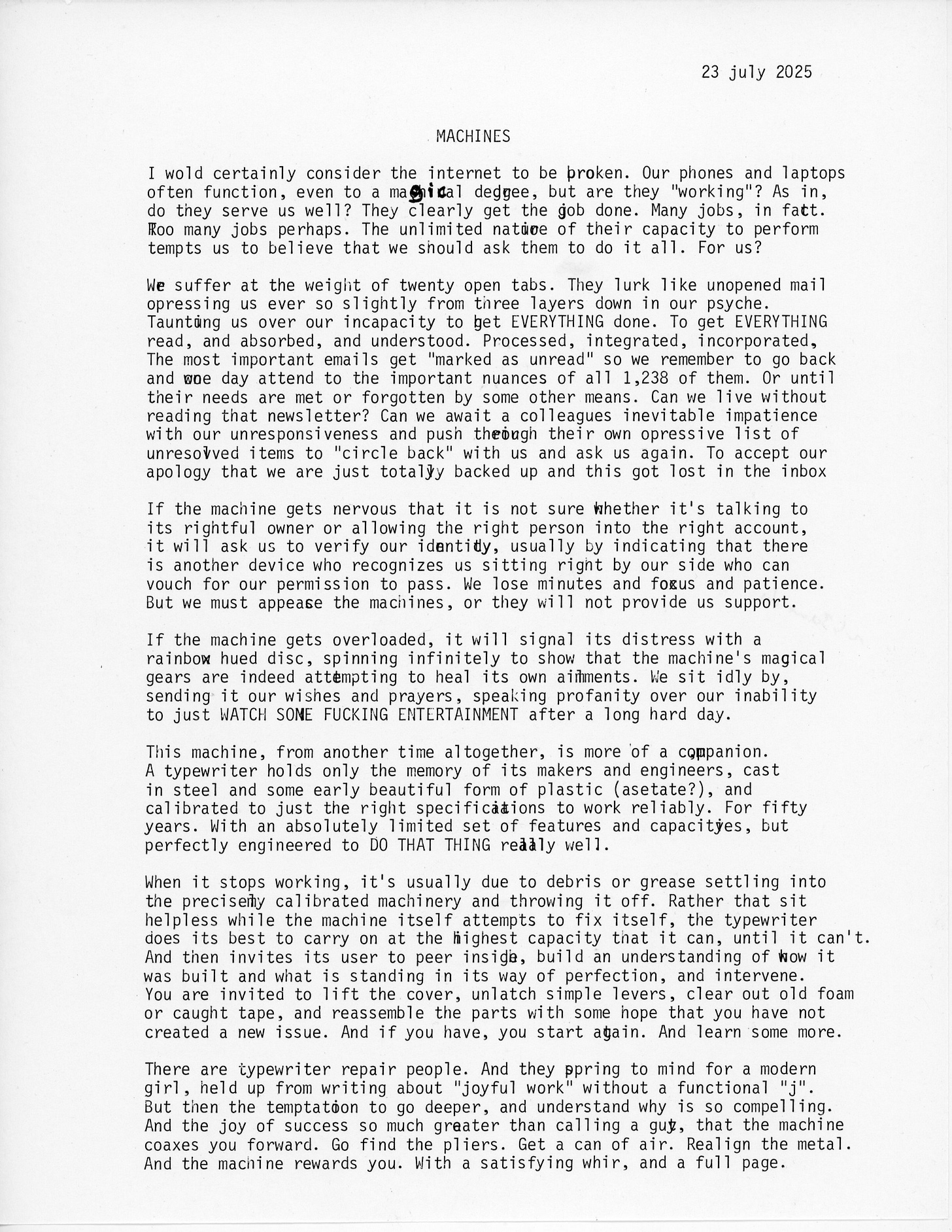Object-ives #6: An Ode to My IBM Selectric Typewriter
On the joys of an analog machine in a digital world
The Selectric entered into my routine just as swiftly as it made its way into my imagination. I type to think these days. To get my ideas down on paper. Publishing away from the minefield of the internet. Printing with the immediacy of a key strike. Stacking all of my imperfections and happy accidents in a pile on my desk.
The wisdom of an analog machine and its structural companionship feel warmer and more welcome every day. To type on paper is to be liberated of a thousand decisions and the blockages of self-doubt. Free to explore ideas without concern for an audience. Distant from the millions of disparate views that fray my nerves, overload my mind, and drain my finite stores of energy and attention.
My fascination with the IBM Selectric typewriter began before I learned its name. I happened on a 1972 copy of the Whole Earth Catalog in a used bookstore, and spent hours with its dense pages, vast scope, and expansive legacy in the months that followed. These 448 pages of useful tools for intentional living inspired millions and resourced movements. The authors credit the Selectric typewriter as “the tool that made our operation possible.”
This machine revolutionized typing in its time—replacing hammer keys with a round golf ball of text, doubling typing speeds, and allowing users to switch font sizes and styles. My mother shares warm memories of being the first in her office to get one. Famous authors like John McPhee have paid tribute to it, even when they used another model. Radical publications of the 70s such as Abbie Hoffman’s Steal This Book encouraged readers to buy or rent a Selectric and put the power of the printed page in their hands.
Fifty years later, this endorsement still holds up.
As I recover from the burnout from modern office life, and make sense of a decade of organizing, this machine called out to me. It offered to give me respite from the storm of endless engagement. It reminded me I could be alone with my thoughts. It invited me to make new routines and solve new problems with my own hands.
While daily, I still hear the din of a million voices vying to be the loudest, the Selectric holds a space for me to hear my own.
I write in a sunny corner of our house. I crack the window to commune with birds and sirens and afternoon breezes that remind me of my place in the world. I type essays like the one below on one page and in one fell swoop—trusting that one unshakable sentence will lead me into my next idea. And that my un-erasable mistakes will create a poetry of their own.
I’ve grown to love the whir of the Selectric’s motor, the manual tabs and margins of a project, and the gentle shout of typing in all caps. I love to commune with its structural memory and the genius of its construction and design. I am touched by its persistence to keep working through my novice mistakes and empowered by my ability to pop open its metal cover and take a look around.
Machines serve as extensions of our bodies and companions to our human will. They specialize in tackling a task as perfectly as they can. Gears, levers, keys, and tape are uncomplicated in their purpose and intent. They sit idly by our sides as we work our problems out, ready to jump to our aid upon request. They leave our minds uncluttered of their problems. The issues of old machines are simple mechanics. The ball remains in our court.
To reconnect with this old truth is to reclaim a human experience of agency and imagination—accessible when we choose. Analog machines hold an authentic intelligence not unlike our own.
They remind us of what we can accomplish with our bodies and our minds. They do not ask to see ID. They do not question our authority. They do not aim to obfuscate, instigate, or overwhelm. They sit in a sunny corner of the house and welcome you back. With all your imperfections. And invite you to try. And try again.
Michelle Geiss organizes people and ideas to drive positive change in the world. She has twenty years experience leading social change initiatives that leverage economies to work for people. For the last decade, she has dedicated most of her waking hours to advancing systems change and community development alongside Baltimore’s visionary leaders and social entrepreneurs. Today, she makes sense of her experiences through writing, collage, craft, and beekeeping. She is documenting her learning journey at Atlantic Bee Company here on Substack and out in the real world.
Object-ives features flash nonfiction essays of 500-999 words on the possessions we can’t stop thinking about.
Recommended reading on possessions:
“Why I still collect DVDs” by Stephanie Nguyen, The Daily Californian
“‘Cluttercore’ Is Trending—Here’s How to Make It Feel Intentional, According to Designers” by Yelena Moroz-Alpert, House Beautiful
“What a Professional Organizer Thinks You Should Do With Inherited Clutter” by Blake Bakkila, Sunset
“Antiques Roadshow fan slams expert for bold move toward guitar worth five figures” by Hannah Furnell, The Express
“Revisiting '80s Fragrances” by
, , and“Less Is Liberation Challenge: Day 3” by
, author of new book Less Is Liberation, on decluttering one surface at a time





Boy this takes me back. I went to work for IBM in Lexington, KY in 1979. My first job there paid $183/week and I placed typewriter parts into a plastic bin rolling down an assembly line toward the people who assembled the selectric typewriters. I was later promoted to an assembly position where I spent the next 6 years building Selectric typewriters while learning to be a programmer in the evenings. I’m always shocked when I run across one of those typewriters and your essay on it supports my belief that many are still out there whirring away and capable of functioning the way we built them to!
Loved this, and it also reminded me of the visceral reaction I had recently while watching a video of someone using one of those old sliding credit card machines. The sound! (And thanks for the link to our fragrance story at the end!)